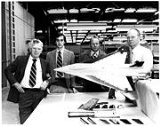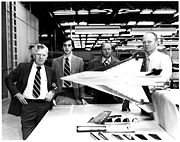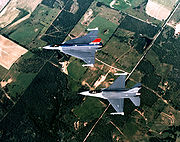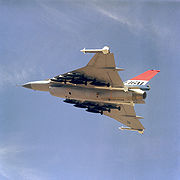
F-16XL
Encyclopedia
The General Dynamics F-16XL is a derivative of the F-16 Fighting Falcon, with a cranked-arrow delta wing. It was entered in the United States Air Force
's (USAF) Enhanced Tactical Fighter
(ETF) competition but lost to the F-15E Strike Eagle. Several years after the prototypes were shelved, they were turned over to NASA
for aeronautical research.
. Under the leadership of Harry Hillaker (father of the original F-16), the original goal of the program was to demonstrate the applicability of supersonic transport
technologies to military aircraft. That year, under the supervision of Hillaker and Jim Gordon, Andrew Lewis was given a supposedly quick project to study the applicability of supersonic transport
technologies to military aircraft. The big wing generated a lot of lift, and typical aerodynamic limitations of delta wings were overcome by the F-16's relaxed static stability
. Kenny Barnes led the work into tweaking the F-16s electronic flight control system to allow control at high angles of attack. The wing was also a big fuel tank which boosted range considerably. The study went on for two years with important contributions from many other engineers, but Lewis was able to stay out in front and designed the wing's plan form, airfoil, twist and camber. The goal of the cranked arrow was to have a high sweep inboard panel for low drag at supersonic speeds, and a low sweep outboard panel that would provide better handling and maneuverability at subsonic speeds.
 Working closely with NASA's Langley Research Center
Working closely with NASA's Langley Research Center
, the company invested significant Internal Research and Development (IRAD) funds for wind tunnel testing and that led to the Model 400. It featured all moving wing tips for roll control and an all moving vertical tail. These surfaces were actually the horizontal tail surfaces from the F-16A. These surfaces were later dropped as they did not provide adequate control at low speed, high angle of attack. Also, there would have been no provision for wing-tip mounted missiles. The main wing incorporated forebody strakes
to enhance vortex generation for high angle of attack
maneuverability, negative stability for improved subsonic lift and reduced supersonic drag. It was built around a 40-inch fuselage stretch. Both the large wing and fuselage stretch yielded a dramatic increase in range at all speeds. In 1979, with a strong positive response by the USAF, GD released the Model 400 for a company funded preliminary design effort.
 In 1980, the USAF signed on as a partner, providing the third and fifth production F-16 airframes. These two airframes became the only extant examples of the F-16XL.
In 1980, the USAF signed on as a partner, providing the third and fifth production F-16 airframes. These two airframes became the only extant examples of the F-16XL.
In March 1981, the USAF announced the Enhanced Tactical Fighter
program to procure a replacement for the F-111 Aardvark. The concept envisioned an aircraft capable of launching deep interdiction
missions without requiring additional support in the form of fighter escort or jamming support. General Dynamics submitted the F-16XL, while McDonnell Douglas
submitted a variant of the F-15 Eagle
. Though the two aircraft were competing for the same role, they were fairly different in design approach: the F-15E is basically an F-15D two-seat trainer with the back-seat station modified to support ground-attack instruments, while the F-16XL has major structural and aerodynamic differences from the original F-16. As such, the XL would have required much more effort, time and money to put into full production. Additionally, the Strike Eagle has two engines, which gives it more thrust and thus the capacity to carry more weapons and/or armor into combat. Furthermore, engine redundancy can be very useful for an aircraft whose mission involves operating within the reach of anti-aircraft artillery (AA) and surface-to-air missile
s (SAM), in addition to the standard threats of fighter aircraft
and interceptors.
at Edwards AFB
. Designed and built by North American Aviation
(a division of Rockwell International
), the glove had laser-cut holes that were nominally 0.0025 in (0.0635 mm) diameter. Distance between holes varied between 0.010 and 0.055 in (0.25 and 1.40 mm) depending on the suction. The glove covered over 5 ft² (0.5 m²) of the wing. It was intended to suck away turbulent airflow
over the wing, restoring laminar flow
and reducing drag
. The aircraft was also involved in testing sonic boom
characteristics, takeoff performance, and engine noise, for NASA's civil transport program.
The second aircraft (a two-seater) had its experimental engine replaced with a General Electric F110-129
. It accidentally achieved supercruise
, a design goal of the F-16XL that was never attained in ETF testing, when it reached Mach 1.1 at 20,000 ft (6,096 m) on full military power. It was mounted with a passive fiberglass and foam glove on the right wing to examine supersonic flow, and an active glove on the left wing. This second glove was composed of fiberglass and foam over a titanium skin, and covers 75% of the wing's surface and 60% of its leading edge. The active portion consists the middle two-thirds of the glove, with laser-drilled holes leading to cavities beneath the wing. It was designed collaboratively by Langley research center, Dryden, Rockwell, Boeing, and McDonnell Douglas. The glove is intended as a testbed for supersonic laminar flow.
The F-16XL flight project office was located at the NASA Dryden Flight Research Center
, Edwards AFB, CA. The NASA Langley Research Center
, developed and coordinated F-16XL experiments.
At the conclusion of their test programs in 1999, both F-16XLs were placed into storage at NASA Dryden. In 2007, NASA approached Lockheed Martin to request a study into the feasibility and cost of returning F-16XL #1 to flight status and upgrading it with many of the improvements found in the USAF's Block 40 F-16s. As of July 2007, the study is still underway; however, in the meantime F-16XL #1 has been taxi tested at Dryden and given systems checks.
 The wing and rear horizontal control surfaces were replaced with a cranked-arrow delta wing 120% larger than the original wing. Extensive use of carbon fiber composites allowed the savings of 600 lb (270 kg) of weight but the F-16XL was still 2,800 lb (1300 kg) heavier than the original F-16A.
The wing and rear horizontal control surfaces were replaced with a cranked-arrow delta wing 120% larger than the original wing. Extensive use of carbon fiber composites allowed the savings of 600 lb (270 kg) of weight but the F-16XL was still 2,800 lb (1300 kg) heavier than the original F-16A.
Less noticeable is that the fuselage was lengthened by 56 in (1.4 m) by the addition of 2 sections at the joints of the main fuselage sub-assemblies. With the new wing design, the tail section had to be canted up 3°, and the ventral fins removed, to prevent them from striking the pavement during takeoff and landing. However, as the F-16XL exhibits greater stability than the native F-16, these changes were not detrimental to the handling of the aircraft.
These changes resulted in a 25% improvement in maximum lift-to-drag ratio in supersonic flight and 11% in subsonic flight, and a plane that reportedly handled much smoother at high speeds and low altitudes. The enlargements increased fuel capacity by 82%. The F-16XL could carry twice the ordnance of the F-16 and deliver it 40% further. The enlarged wing allowed a total of 27 hardpoints on the plane:
However, the "heavy/wet" stations interfered with up to 4 wing stations

United States Air Force
The United States Air Force is the aerial warfare service branch of the United States Armed Forces and one of the American uniformed services. Initially part of the United States Army, the USAF was formed as a separate branch of the military on September 18, 1947 under the National Security Act of...
's (USAF) Enhanced Tactical Fighter
Enhanced Tactical Fighter
Enhanced Tactical Fighter was a programme conducted by the United States Air Force between 1980 and 1984, to seek replacements for the F-111....
(ETF) competition but lost to the F-15E Strike Eagle. Several years after the prototypes were shelved, they were turned over to NASA
NASA
The National Aeronautics and Space Administration is the agency of the United States government that is responsible for the nation's civilian space program and for aeronautics and aerospace research...
for aeronautical research.
SCAMP
In 1977, the F-16XL started out as the F-16 SCAMP (Supersonic Cruise and Maneuver Prototype) at General Dynamics Fort WorthGeneral Dynamics
General Dynamics Corporation is a U.S. defense conglomerate formed by mergers and divestitures, and as of 2008 it is the fifth largest defense contractor in the world. Its headquarters are in West Falls Church , unincorporated Fairfax County, Virginia, in the Falls Church area.The company has...
. Under the leadership of Harry Hillaker (father of the original F-16), the original goal of the program was to demonstrate the applicability of supersonic transport
Supersonic transport
A supersonic transport is a civilian supersonic aircraft designed to transport passengers at speeds greater than the speed of sound. The only SSTs to see regular service to date have been Concorde and the Tupolev Tu-144. The last passenger flight of the Tu-144 was in June 1978 with its last ever...
technologies to military aircraft. That year, under the supervision of Hillaker and Jim Gordon, Andrew Lewis was given a supposedly quick project to study the applicability of supersonic transport
Supersonic transport
A supersonic transport is a civilian supersonic aircraft designed to transport passengers at speeds greater than the speed of sound. The only SSTs to see regular service to date have been Concorde and the Tupolev Tu-144. The last passenger flight of the Tu-144 was in June 1978 with its last ever...
technologies to military aircraft. The big wing generated a lot of lift, and typical aerodynamic limitations of delta wings were overcome by the F-16's relaxed static stability
Relaxed stability
In aviation, relaxed stability is the tendency of an aircraft to change its attitude and angle of bank of its own accord. An aircraft with relaxed stability will oscillate in simple harmonic motion around a particular attitude at an increasing amplitude....
. Kenny Barnes led the work into tweaking the F-16s electronic flight control system to allow control at high angles of attack. The wing was also a big fuel tank which boosted range considerably. The study went on for two years with important contributions from many other engineers, but Lewis was able to stay out in front and designed the wing's plan form, airfoil, twist and camber. The goal of the cranked arrow was to have a high sweep inboard panel for low drag at supersonic speeds, and a low sweep outboard panel that would provide better handling and maneuverability at subsonic speeds.

Langley Research Center
Langley Research Center is the oldest of NASA's field centers, located in Hampton, Virginia, United States. It directly borders Poquoson, Virginia and Langley Air Force Base...
, the company invested significant Internal Research and Development (IRAD) funds for wind tunnel testing and that led to the Model 400. It featured all moving wing tips for roll control and an all moving vertical tail. These surfaces were actually the horizontal tail surfaces from the F-16A. These surfaces were later dropped as they did not provide adequate control at low speed, high angle of attack. Also, there would have been no provision for wing-tip mounted missiles. The main wing incorporated forebody strakes
Strake (aviation)
In aviation, a strake is an aerodynamic surface generally mounted on the fuselage of an aircraft to improve the airflow and hence the flight characteristics.In general a strake is longer than it is wide, in contrast to a winglet or a moustache....
to enhance vortex generation for high angle of attack
Angle of attack
Angle of attack is a term used in fluid dynamics to describe the angle between a reference line on a lifting body and the vector representing the relative motion between the lifting body and the fluid through which it is moving...
maneuverability, negative stability for improved subsonic lift and reduced supersonic drag. It was built around a 40-inch fuselage stretch. Both the large wing and fuselage stretch yielded a dramatic increase in range at all speeds. In 1979, with a strong positive response by the USAF, GD released the Model 400 for a company funded preliminary design effort.
Enhanced Tactical Fighter competition

In March 1981, the USAF announced the Enhanced Tactical Fighter
Enhanced Tactical Fighter
Enhanced Tactical Fighter was a programme conducted by the United States Air Force between 1980 and 1984, to seek replacements for the F-111....
program to procure a replacement for the F-111 Aardvark. The concept envisioned an aircraft capable of launching deep interdiction
Air interdiction
Air interdiction is the use of aircraft to attack tactical ground targets that are not in close proximity to friendly ground forces. It differs from close air support because it does not directly support ground operations and is not closely coordinated with ground units...
missions without requiring additional support in the form of fighter escort or jamming support. General Dynamics submitted the F-16XL, while McDonnell Douglas
McDonnell Douglas
McDonnell Douglas was a major American aerospace manufacturer and defense contractor, producing a number of famous commercial and military aircraft. It formed from a merger of McDonnell Aircraft and Douglas Aircraft in 1967. McDonnell Douglas was based at Lambert-St. Louis International Airport...
submitted a variant of the F-15 Eagle
F-15E Strike Eagle
The McDonnell Douglas F-15E Strike Eagle is an all-weather multirole fighter, derived from the McDonnell Douglas F-15 Eagle. The F-15E was designed in the 1980s for long-range, high speed interdiction without relying on escort or electronic warfare aircraft. United States Air Force F-15E Strike...
. Though the two aircraft were competing for the same role, they were fairly different in design approach: the F-15E is basically an F-15D two-seat trainer with the back-seat station modified to support ground-attack instruments, while the F-16XL has major structural and aerodynamic differences from the original F-16. As such, the XL would have required much more effort, time and money to put into full production. Additionally, the Strike Eagle has two engines, which gives it more thrust and thus the capacity to carry more weapons and/or armor into combat. Furthermore, engine redundancy can be very useful for an aircraft whose mission involves operating within the reach of anti-aircraft artillery (AA) and surface-to-air missile
Surface-to-air missile
A surface-to-air missile or ground-to-air missile is a missile designed to be launched from the ground to destroy aircraft or other missiles...
s (SAM), in addition to the standard threats of fighter aircraft
Fighter aircraft
A fighter aircraft is a military aircraft designed primarily for air-to-air combat with other aircraft, as opposed to a bomber, which is designed primarily to attack ground targets...
and interceptors.
Evaluation
In February 1984, the USAF awarded the ETF contract to McDonnell Douglas. Both F-16XL aircraft were returned to the Air Force and placed in storage.NASA
In 1988, the two aircraft were taken out of storage and turned over to NASA for research. The first aircraft was fitted with an active suction titanium glove encasing the left wing and delivered to the Ames-Dryden Flight Research FacilityDryden Flight Research Center
The Dryden Flight Research Center , located inside Edwards Air Force Base, is an aeronautical research center operated by NASA. On March 26, 1976 it was named in honor of the late Hugh L. Dryden, a prominent aeronautical engineer who at the time of his death in 1965 was NASA's deputy administrator...
at Edwards AFB
Edwards Air Force Base
Edwards Air Force Base is a United States Air Force base located on the border of Kern County, Los Angeles County, and San Bernardino County, California, in the Antelope Valley. It is southwest of the central business district of North Edwards, California and due east of Rosamond.It is named in...
. Designed and built by North American Aviation
North American Aviation
North American Aviation was a major US aerospace manufacturer, responsible for a number of historic aircraft, including the T-6 Texan trainer, the P-51 Mustang fighter, the B-25 Mitchell bomber, the F-86 Sabre jet fighter, the X-15 rocket plane, and the XB-70, as well as Apollo Command and Service...
(a division of Rockwell International
Rockwell International
Rockwell International was a major American manufacturing conglomerate in the latter half of the 20th century, involved in aircraft, the space industry, both defense-oriented and commercial electronics, automotive and truck components, printing presses, valves and meters, and industrial automation....
), the glove had laser-cut holes that were nominally 0.0025 in (0.0635 mm) diameter. Distance between holes varied between 0.010 and 0.055 in (0.25 and 1.40 mm) depending on the suction. The glove covered over 5 ft² (0.5 m²) of the wing. It was intended to suck away turbulent airflow
Turbulence
In fluid dynamics, turbulence or turbulent flow is a flow regime characterized by chaotic and stochastic property changes. This includes low momentum diffusion, high momentum convection, and rapid variation of pressure and velocity in space and time...
over the wing, restoring laminar flow
Laminar flow
Laminar flow, sometimes known as streamline flow, occurs when a fluid flows in parallel layers, with no disruption between the layers. At low velocities the fluid tends to flow without lateral mixing, and adjacent layers slide past one another like playing cards. There are no cross currents...
and reducing drag
Drag (physics)
In fluid dynamics, drag refers to forces which act on a solid object in the direction of the relative fluid flow velocity...
. The aircraft was also involved in testing sonic boom
Sonic boom
A sonic boom is the sound associated with the shock waves created by an object traveling through the air faster than the speed of sound. Sonic booms generate enormous amounts of sound energy, sounding much like an explosion...
characteristics, takeoff performance, and engine noise, for NASA's civil transport program.
The second aircraft (a two-seater) had its experimental engine replaced with a General Electric F110-129
General Electric F110
-External links:* - The F110 Engine Family* - F110-GE-100 Gallery* - F110* - General Electric F110...
. It accidentally achieved supercruise
Supercruise
Supercruise is sustained supersonic flight of an aircraft with a useful cargo, passenger, or weapons load performed efficiently and without the use of afterburners ....
, a design goal of the F-16XL that was never attained in ETF testing, when it reached Mach 1.1 at 20,000 ft (6,096 m) on full military power. It was mounted with a passive fiberglass and foam glove on the right wing to examine supersonic flow, and an active glove on the left wing. This second glove was composed of fiberglass and foam over a titanium skin, and covers 75% of the wing's surface and 60% of its leading edge. The active portion consists the middle two-thirds of the glove, with laser-drilled holes leading to cavities beneath the wing. It was designed collaboratively by Langley research center, Dryden, Rockwell, Boeing, and McDonnell Douglas. The glove is intended as a testbed for supersonic laminar flow.
The F-16XL flight project office was located at the NASA Dryden Flight Research Center
Dryden Flight Research Center
The Dryden Flight Research Center , located inside Edwards Air Force Base, is an aeronautical research center operated by NASA. On March 26, 1976 it was named in honor of the late Hugh L. Dryden, a prominent aeronautical engineer who at the time of his death in 1965 was NASA's deputy administrator...
, Edwards AFB, CA. The NASA Langley Research Center
Langley Research Center
Langley Research Center is the oldest of NASA's field centers, located in Hampton, Virginia, United States. It directly borders Poquoson, Virginia and Langley Air Force Base...
, developed and coordinated F-16XL experiments.
At the conclusion of their test programs in 1999, both F-16XLs were placed into storage at NASA Dryden. In 2007, NASA approached Lockheed Martin to request a study into the feasibility and cost of returning F-16XL #1 to flight status and upgrading it with many of the improvements found in the USAF's Block 40 F-16s. As of July 2007, the study is still underway; however, in the meantime F-16XL #1 has been taxi tested at Dryden and given systems checks.
Design

Less noticeable is that the fuselage was lengthened by 56 in (1.4 m) by the addition of 2 sections at the joints of the main fuselage sub-assemblies. With the new wing design, the tail section had to be canted up 3°, and the ventral fins removed, to prevent them from striking the pavement during takeoff and landing. However, as the F-16XL exhibits greater stability than the native F-16, these changes were not detrimental to the handling of the aircraft.
These changes resulted in a 25% improvement in maximum lift-to-drag ratio in supersonic flight and 11% in subsonic flight, and a plane that reportedly handled much smoother at high speeds and low altitudes. The enlargements increased fuel capacity by 82%. The F-16XL could carry twice the ordnance of the F-16 and deliver it 40% further. The enlarged wing allowed a total of 27 hardpoints on the plane:
- 16 wing stations of capacity 750 lb (340 kg) each
- 4 semi-recessed AIM-120 AMRAAMAIM-120 AMRAAMThe AIM-120 Advanced Medium-Range Air-to-Air Missile, or AMRAAM , is a modern beyond-visual-range air-to-air missile capable of all-weather day-and-night operations. Designed with the same form-factor as the previous generation of semi-active guided Sparrow missiles, it is a fire-and-forget...
stations under fuselage - 2 wingtip stations
- 1 centerline station
- 2 wing "heavy/wet" stations
- 2 chin LANTIRNLANTIRNLow Altitude Navigation and Targeting Infrared for Night, or LANTIRN, is a combined navigation and targeting pod system for use on the USAF's premier fighter aircraft — the F-15E Strike Eagle and F-16 Fighting Falcon...
stations
However, the "heavy/wet" stations interfered with up to 4 wing stations
Specifications (F-16XL number 2)

See also
External links
- NASA/DFRC F-16XL photo gallery number 1, photo gallery number 2
- F-16XL experiment report, NASA, December 1999
- The Revolutionary Evolution of the F-16XL, Air Force magazine, November 1983
- NASA Could Put The F-16XL Back In The Air, Flight International, 2007
- Harry Hillaker — Father of the F-16
- F-16XL, in Joe Baugher's site

